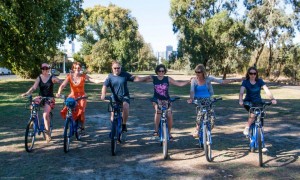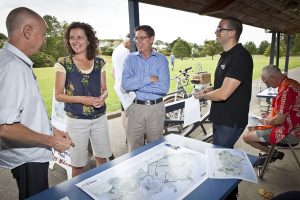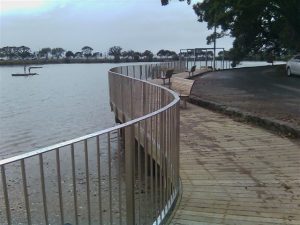This report covers my activities from 1 March – 31 March 2013.
Board activities
Annual plan hearings for Waitemata Local Board
I found our hearings day held on 19 March to be extremely interesting, worthwhile and productive. We were fortunate to have a range of passionate submitters and to be joined by three governing body members who added to the value of the hearings.
I would just query why the Orakei Local Board decided to submit to a number of fellow boards including Waitemata. There are a range of projects we may wish to collaborate on but the annual plan process is not intended nor structured to provide for different parts of the Auckland Council family to submit as members of the public. I would like to see Local Board services give a clear direction on this issue for next year.
Grants Committee meeting
The Grants Committee met on 27 March to consider 18 applications totally $68,573.98 to the Waitemata Local Board’s third round of discretionary funding. The committee agenda is available online. Thank you to all the applicants who came along to speak in support of their applications.
The recommendations of the committee will be referred to the Board’s business meeting on 9 April. The last and fourth round of funding for this financial year is open until Friday 26th April. (application form available here)
Relationship between CCO’s and Local Boards
At our February meeting we received the report and resolutions from the Accountability and Performance Committee – Relationship between Local Boards and Council Controlled Organisations
It was delegated to the Board Chair and Deputy Chair to work with Local Board Services officers to provide feedback to the Committee on the type of engagement the Waitemata Local Board would like with Council Controlled Organisations.
This feedback is attached as ATTACHMENT A.
It should also be noted that CCO’s are required to report to the Governing Body on their engagement with Local Boards and that Auckland Transport has been directed to hold workshops with Local Board on their prioritisation criteria in early 2013. This workshop has yet to occur and Auckland Transport, Waterfront Auckland and ACPL have not provided Local Board Services with their engagement plans for 12/13.
Professional development
During March I have taken advantage of a number of excellent learning opportunities available to board members.
Re-thinking Pacific Auckland, Damon Salesa, Associate Professor, Centre for Pacific Studies, University of Auckland – a lunchtime learning hosted by the Research, Investigations and Monitoring Unit.
This presentation highlighted the high degree of racial segregation occurring in Auckland (using census and demographic data) which is not talked about and therefore not addressed. There are serious consequences of this segregation not just within lower socio-economic areas. Pakeha who attend racially segregated schools are also educationally disadvantaged.
It means differences of opportunity and attainment and damages confidence in democracy.
The presenter gave as the number one solution building social housing in wealthier areas – he felt strongly that no development should happen at the waterfront without social housing.
I would like the Waitemata Local Board to ensure it meets the challenge given by the presenter of working to create the World’s most liveable city for EVERYONE.
Innovation Auckland Conference
SOCANZ conference on 25 and 26 March (conference report to be provided next month)
The conference presented energetic experts on social entrepreneurship and a range of workshops on a cross-section of subjects.
Place making session – connecting Auckland Place Makers
Ethan Kent, International Place advocate for the Project for Public Spaces. Hosted by Waterfront Auckland at the Cloud
“If you plan for cars and traffic you get cars and traffic, if you plan for people and places you get people and places”
The presentation held up place making as a transformative agenda going through the key attributes that make a good place, describing place making opportunities and benefits.
Natalie Nicholles, associate director, new economics foundation (nef) London
Local economic development – a community development approach for the ‘toolbox’ – a session for Local Board members
Provided a practical overview of nef’s innovative, tried-and-tested local economic development tools:
– developing community knowledge about local wealth creation, and why it matters
– building community capability to assess where and how money and resources leak out of local
I also used a private visit to Melbourne to learn more about what it takes to create the world’s most liveable city with lots of people cycling for transport (report here)
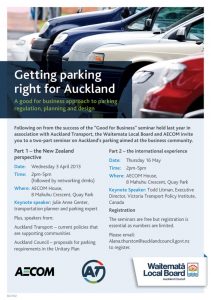 Getting Parking Right for Auckland Seminar
Getting Parking Right for Auckland Seminar
Invites went out in early March for the seminar on 3 April to all of the business associations, CBD advisory board members, local board members and a number of councillors.
An impressive line up of experts, including Chief Economist, Geoff Cooper are included in the programme.
Portfolio reports
Transport
The Transport portfolio monthly briefing with Auckland Transport took place on 21 March 2013. We covered:
-
Road safety campaigns
-
Parking issues in Parnell, Freemans Bay and the Strand
-
Eden Terrace parking zone update
-
St Mary’s Bay parking business permits
-
Road Corridor Operations latest updates
Full details of current proposals and issues are outlined in Auckland Transport’s monthly report attached to the Board agenda.
Parking
Parking continues to be an issue for many neighbourhoods in our board area. In Freemans Bay nearly all the unrestricted on-street parking is taken up daily by commuters making it difficult for visitors and residents to access parking spaces. Freemans Bay is the number one priority for a residents parking scheme applying the lessons Auckland Transport has learnt from the St Marys Bay trial.
In February we heard from residents of Scarborough Tce at our monthly board meeting about the parking issues on their street. Auckland Transport is investigating a number of options for a scheme that needs to be effective in a mixed use area with high occupancy rates into the evening.
In Eden Tce we heard that Auckland Transport successfully presented to the Business Association on a proposal for a paid parking zone with a limited number of free on -street parking areas. As part of implementing a new parking scheme Auckland Transport is able to work with the local businesses to offer free public transport for 3 weeks, bike hire and car pool software with a travel plan for the area.
In St Marys Bay Auckland Transport is continuing to assess the trial and how best to deal with the request for business permits. One option being considered is to allow for a limited number of coupons for daily parking (similar to the coupon scheme in Wellington).
What is clear from all the investigations that AT is undertaking is that each neighbourhood will require an appropriate parking scheme to be developed to fit the particular community needs.
Road safety
I have raised concerns with Auckland Transport that their latest campaign aimed at pedestrians is ill-conceived and unlikely to resonant with the target audience. The Pay Attention or Pay the price campaign is aimed at young people who are involved in large number of accidents in the city centre.
However what I have learnt from safety campaign experts such as Jonathan Daly is that these kinds of messages don’t work as they are missing the key ingredient of empathy. It is human nature to switch off to messages such as “Slow down”, “Pay Attention”, “Be polite “
I think this campaign also doesn’t recognise current realities regarding how people – especially young people -choose to move around the city and how Auckland streets are being designed that even work to encourage distractions (such as shared spaces).
Of course pedestrians need to take care but I believe this campaign will lead to a greater tendency to blame the victim of road accidents involving pedestrians which is nearly always the pedestrian.
Interestingly we found out that AT uses a very small focus group sample on which to test safety messages. From the representative sample that we were shown all of the responders asked AT to not waste money on the campaign but to invest in more pedestrian friendly street design.
Richmond Road School
After more than 4 years of pushing for improved safety improvements on Richmond Road the school has been successful in Auckland Transport approving a range of measures.
I attended a meeting with the principal, Stephanie Anich, representatives of Auckland Transport and Cycle Action on 22 March to discuss the current proposals which are either underway or about to start. These improvements include:
-
Relocating the bus stop near the school to provide for greater visibility
-
Installation of electronic repeater 40km/h signs
-
Installing school zone signs
-
Improvements to the crossing layout
-
New markings and raised speed strips to encourage slower speeds
These safety improvements are being undertaken as part of the overall Richmond Road safety action plan which is a local board project.
Promoting active transport for events
 I have raised with Auckland Transport and ATEED the lack of promotion for active transport as an option for travel to events over the summer. For example the promotion for travel to Pasifika was just focused on using the park and ride facilities. No bike parking was provided at the event despite it taking place right next to the north western cycle way.
I have raised with Auckland Transport and ATEED the lack of promotion for active transport as an option for travel to events over the summer. For example the promotion for travel to Pasifika was just focused on using the park and ride facilities. No bike parking was provided at the event despite it taking place right next to the north western cycle way.
I am also aware of the large number of complaints that have been directed to Auckland Transport regarding the lack of planning to cope with the large numbers using public transport to attend events particularly over the weekend of 9/10 March. AT have advised that their Special Events Team will review all available data and apply the learnings to planning for future events so that the travelling public is better served.
Other board activities
Local Board Workshops and meetings
I attended during March:
-
Waitemata Local Board workshop on 5 March
-
Meeting to discuss Waitemata Local Board feedback on the Unitary Plan & current status of the draft Unitary Plan
-
Symonds Street cemetery public meeting on 5 March
-
Waitemata community facility needs meeting
-
Informal meeting with Waterfront Auckland CEO, John Dalziell
-
AT Briefing on cycle connections to the Grafton Gully Cycleway
-
Coxs Bay Advisory Group meeting on 7 March
-
Local Board briefing on the Sale and Supply of Alcohol Act 2012 changes to the current liquor licensing framework
-
Planning for Parnell Baths Centennial Celebration in March 2014
-
Ponsonby Road Master Plan – Working Group Workshop 2: Issues, Opportunities and Aspirations on 11 March
-
Meeting with Philip Jones, Architect for Ponsonby Central to discuss proposed parking and bus stop changes on Ponsonby Road and Brown Street
-
Communications fortnightly update
-
Meeting with the solid waste team to discuss the work underway to encourage zero waste events
-
Waitemata Local Board business meeting in Parnell on 12 March
-
Waitemata Local Board workshop on 12 March
-
Initial meeting of the working group on neighbourhood planning convened by Roger Blakely on 15 March
-

Launch of Unitary Plan and attendance at the business and heritage sessions held during the day (pictured)
-
Meeting to discuss Pioneer Women’s Hall redevelopment budget and process
-
Fortnightly catch up on the Ponsonby Road master plan progress
-
Annual Plan hearings for Waitemata Local Board on 19 March
-
Re-thinking Pacific Auckland lunchtime learning. Presentation by Damon Salesa, Associate Professor, Centre for Pacific Studies, University of Auckland
-
Auckland Transport monthly catch up for Transport portfolio holders on 21 March
-
Richmond Road School meeting on 22 March organised by Auckland Transport to discuss the proposed safety measures to be introduced outside the school
-
Meeting with representatives of Albert – Eden, Puketapapa Local Boards and the solid waste team to discuss the next stage for the resource recovery centre
-
SOCANZ innovation Auckland Conference on 25 and 26 March
-
Workshop for place makers with Ethan Kent on 25 March hosted by Waterfront Auckland
-
Waitemata Local Board Community Grants Committee meeting on 27 March
-
Ponsonby Road fortnightly update meeting
-
Briefing from Rob Cairns, Manager, Region wide Community Planning and Policy regarding Auckland Domain Governance
-
Natalie Nicholls, new economics foundation for an in-depth conversation for Local Board members regarding local economic development
Events and functions
The Auckland Arts Festival 2013 was a big highlight of the events calendar during March. I was fortunate to attend the following performances
-
The opening night of The Factory and drinks afterwards at the Festival bar (at the invitation of AAF)
-
Breath of the Volcano at the Auckland Domain
-
Hui at Q Theatre (at the invitation of AAF)
-
One Man, Two Guvnors
-
Urban by Circolumbia (at the invitation of AAF)
-
Cantina at the Festival tent
I also attended during March
-
International women’s day celebration at Khartoum Place on 8 March
-
Pasifika Festival at Western Springs
-
Grafton Cricket Club’s 150th birthday celebratory dinner (at the invitation of GCC)
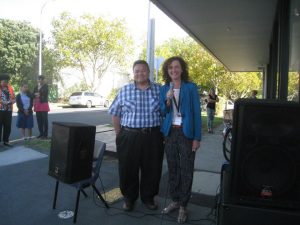
-
BeSpoke – Cycle Style at Silo Park (I was part of the organising team as coordinator of Frocks on Bikes – Auckland)
-
Grey Lynn Business Association March networking drinks
- Ponsonby Road Market Day
-
Movies in Parks at Grey Lynn Park on 16 March
-
West Lynn Street Party and Twilight market in celebration of neighbours day Aotearoa on 21 March (I had the privilege of opening the event with Rev Faasoo (pictured)
-
Genesis Energy Whio Breakfast at the Auckland Zoo on 22 March
-
Opening of the Sir Paul Reeves Building at AUT on 22 March
- Urbis Design Day off ramp installation (viewed from the K’rd over bridge) – how would you like the city to move? (pictured)

 At a Getting Parking Right for Auckland seminar in April [hosted by the Waitemata Local Board and AECOM] we heard that parking supply is not the problem, rather poorly managed oversupply. A total of 80 per cent of off-street parking is privately owned, which hinders its effective use. For example, minimum parking quantities in our current district plans means some car parks are only used during the day by commuters and shoppers while other car parks are used only at night for entertainment. Using land for empty car parks is hugely wasteful.
At a Getting Parking Right for Auckland seminar in April [hosted by the Waitemata Local Board and AECOM] we heard that parking supply is not the problem, rather poorly managed oversupply. A total of 80 per cent of off-street parking is privately owned, which hinders its effective use. For example, minimum parking quantities in our current district plans means some car parks are only used during the day by commuters and shoppers while other car parks are used only at night for entertainment. Using land for empty car parks is hugely wasteful.









